Drought Stress
Learning objectives
Drought stress
Symptoms of drought stress
Water potential magnitude
Analysis of sensitivity to water limitation (MPa)
Measurement of drought stress
Effects of drought stress
WATER STRESS/DROUGHT STRESS
Soil drought, no rain for long time and no-available water in the soil.
Air drought, RH<20% in atmosphere,transpiration>>water absorption. If longer, soil drought occurs.

Symptoms of drought stress
Wilting of the leaves (usually starts at the top of the tree)/young leaves or/and reproductive organs wilt to death
Slowed growth
Chlorosis
Abscission
Thinning of the canopy
Leaves are smaller than normal/smaller leaf area
Marginal necrosis (the leaves turn brown from the outside moving inward
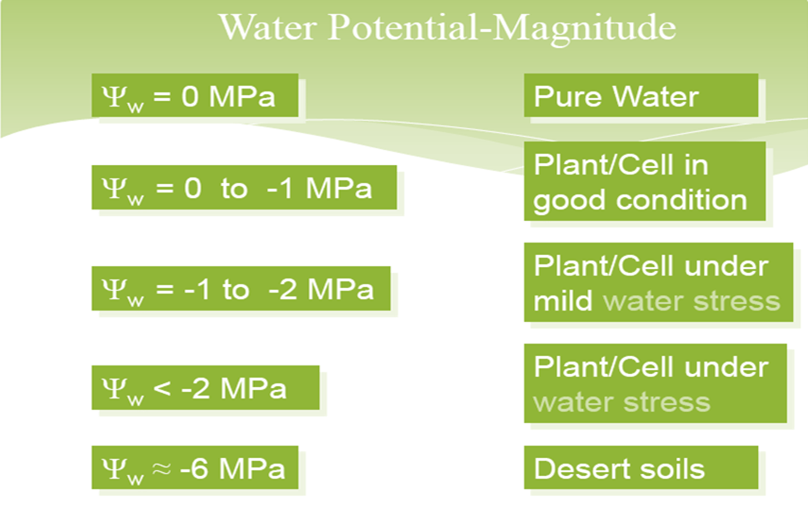
Water Potential-Flux
Water will flow from sites of high ψw (close to zero) to sites of low ψw (more negative):

Analysis of sensitivity to water limitation (MPa)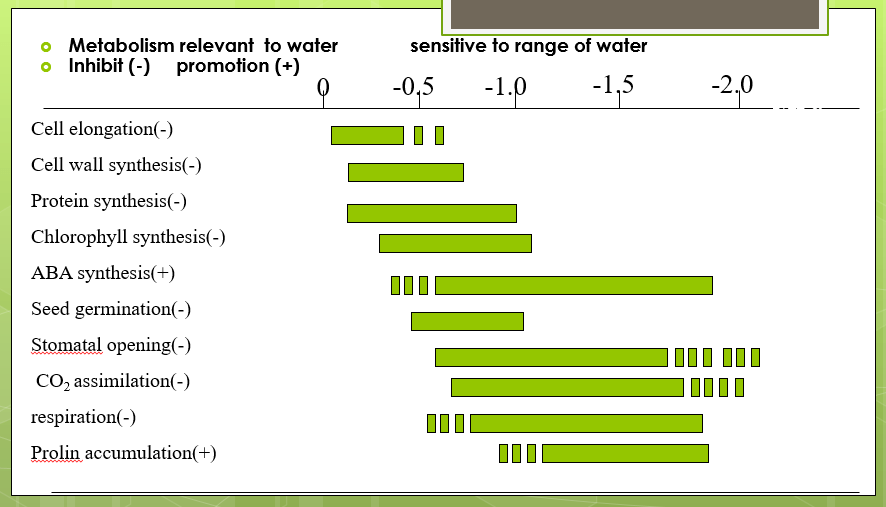
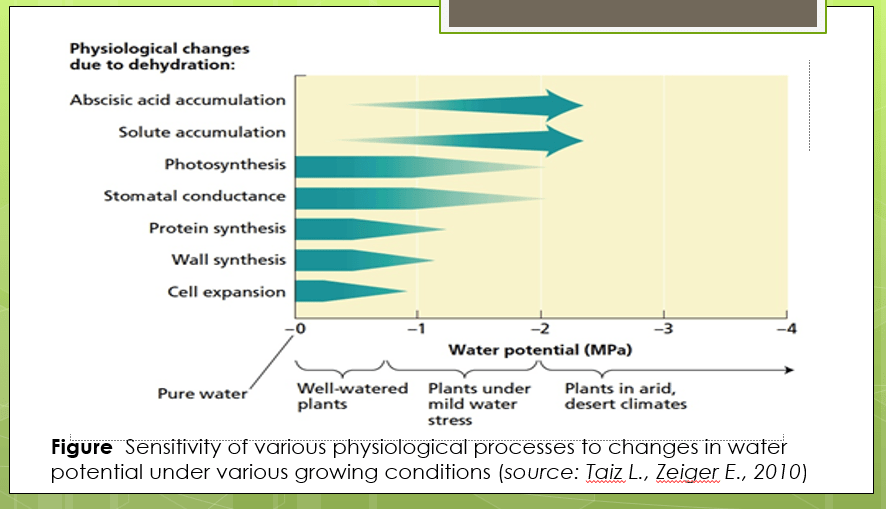
Measurement of Drought Stress

1. Effects of Drought stress on plants
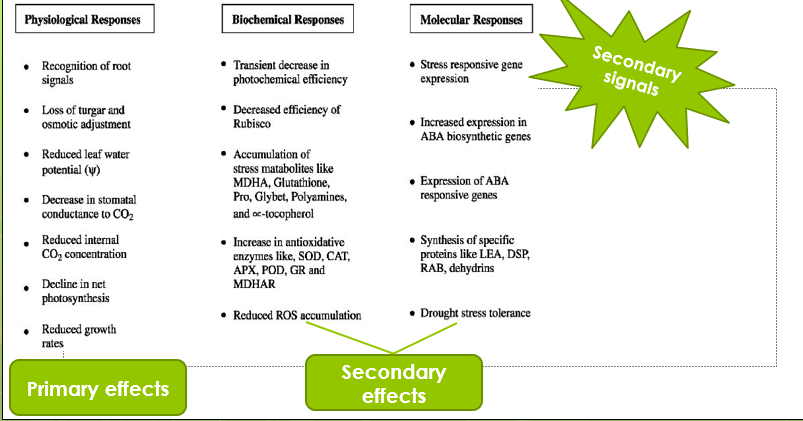
2.1 DS effects on morphological traits
Those crops that have taproot system are more tolerant to short term drought events.
They can stand with mild to moderate drought condition.
On the other hand, prolonged drought can affect all crops likewise and can cause significant yield loss.
2.1.1 DS effects on seedling emergence
Seed germination is the most critical stage in complete life cycle; it is influenced by water availability for imbibition.
Drought stress at this stage can results in irregular germination and deprived seedlings.
In rainfed areas, absence of shower at seedling establishment stage critically reduces field emergence
2.1.2 Growth phase & yield influenced by DS
Water shortage at vegetative stage disturbs growth and development through impaired turgor and stomatal conductance.
The reduction of water potential inside cytosol increases solute level. This leads to damage of cell structure and functioning (osmotic stress).
Cell division and expansion is also inhibited.
Under drought stress, nutrient uptake is also affected that primes to reduction in leaf area and photosynthesis.
Several traits of crops that are affected by drought at vegetative stage include leaf area, assimilation rate, total dry matter and chlorophyll.
Root length and dry weight of leaves and stem is also reduced.
Crop growth & yield
- Growth is accomplished through cell division, cell enlargement and differentiation.
- Cell growth is one of the most drought-sensitive physiological processes due to the reduction in turgor pressure.
- Under severe water deficiency, cell elongation of higher plants can be inhibited by interruption of water flow from the xylem to the surrounding elongating cells
- Reduced water uptake results in a decrease in tissue water contents. As a result,
turgor is lost. - Likewise, drought stress also trims down the photoassimilation and metabolites required for cell division.
- As a consequence, impaired mitosis, cell elongation and expansion result in reduced growth.

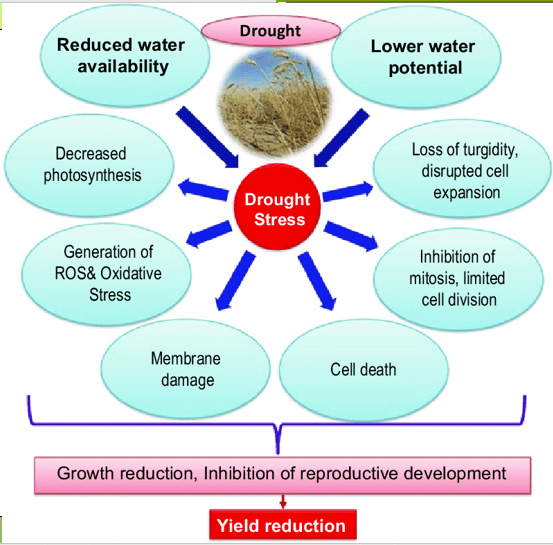

Three main mechanisms reduce crop yield by soil water deficit:
(i) reduced canopy absorption of photosynthetically active radiation (PAR)
(ii) decreased radiation-use efficiency and
(iii) reduced harvest index
- Grain filling in cereals is a process of starch biosynthesis from simple carbohydrates.
- Four enzymes play key roles in this process: *sucrose synthase, *adenosine diphosphate-glucose-pyrophosphorylase, *starch synthase and *starch branching enzyme.
- Decline in the rate of grain growth resulted from reduced sucrose synthase activity, while cessation of growth resulted from inactivation of adenosine diphosphate-glucose-pyrophosphorylase in the water-stressed wheat.
- Water deficit during pollination increased the frequency of kernel abortion in maize (Zea mays).

2.1.4 Effect of DS on crop quality
Among oilseed crops, sunflower has significant importance because it is rich in linoleic acid.
Drought stress at reproductive stage reduces oil quality in oilseed crops and deteriorates its texture.
Drought stress reduces oil quality by disturbing the biochemical enzymes and gene regulation that are responsible for oil constituents in sunflower
2.1.5. Utrastructural changes
Tonoplast may loose structure-releasing vacuolar contents
Chloroplast burst (when in contact with vacuole sap (no recovery after rehydration)
Disruption of compartmentalization-release of hydrolases (acid-alkaline lipases-destroy the membrane of susceptible plants)- cell wall shrinkage- leaf area- transpiration
Inhibition of leaf expansion and shoot growth reduce the consumption of carbon and energy and greater proportion of plant’s assimilates shifted to root system
Proliferation of meristematic tissues of roots root growth improved drought resistance

